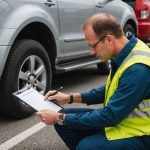Before hitting the road, ensuring that your vehicle is in optimal condition is crucial, especially for truck drivers. A thorough pre-trip safety check can help identify potential issues and guarantee the safety of both the driver and the load being transported. This practice not only adheres to legal requirements but also enhances overall driver safety. In this article, we will guide you through the essential steps you should take to conduct a comprehensive pre-trip inspection of your vehicle, focusing on various components such as brakes, lights, and trailer safety. By the end, you will have a clear understanding of how to effectively perform these checks to ensure a safe and smooth trip.
The Importance of Vehicle Inspections
Vehicle inspections are not just a routine task; they are a fundamental aspect of road safety. Regular checks can significantly reduce the likelihood of breakdowns and accidents, making them essential for all drivers. A well-maintained vehicle performs better and is less likely to face unexpected failures during a trip.
Also read : How can I assess whether my vehicle’s airbags are functioning properly?
When you conduct these inspections, you are making a commitment to safety. Properly maintaining your truck can prevent costly repairs and ensure that your vehicle is always ready for the road. For commercial drivers, this commitment is even more significant, as their livelihoods depend on their ability to transport goods safely and efficiently.
Additionally, being proactive with inspections contributes to driver confidence. Knowing that your vehicle is in top condition allows you to focus on the road rather than worrying about potential issues. This peace of mind is invaluable, especially on long hauls where fatigue can set in. Moreover, systematic inspections help in complying with regulations set forth by transportation authorities, which can save you from fines or penalties.
This might interest you : What role does vehicle maintenance play in preventing accidents?
In summary, conducting regular and thorough inspections should be a non-negotiable part of your driving routine. By prioritizing safety and maintenance, you help ensure not only your well-being but also that of other road users.
Key Areas to Inspect Before a Trip
To ensure your vehicle is ready for the road, focus on several key areas during your pre-trip inspection. Here’s what you need to check:
-
Brakes: Start with the braking system. Check for any unusual sounds or leaks. Ensure that both the air brakes and electric brakes are functioning properly. Test the brake pads and discs to confirm they are not worn down.
-
Lights: All lights must function correctly for maximum visibility and communication with other drivers. Check headlights, brake lights, turn signals, and hazard lights. This ensures your vehicle is seen and signals your intentions clearly.
-
Tires: Inspect the condition of your tires, checking for adequate tread depth and proper inflation. Uneven wear can indicate alignment issues, while low pressure can lead to blowouts.
-
Fluid Levels: Ensure that essential fluids such as oil, coolant, and brake fluid are at the proper levels. Low fluid levels can lead to overheating or brake failure.
-
Trailer Condition: If you are towing a trailer, inspect its hitch and safety chains. Ensure the trailer brakes and lights are operational. Check for any visible damage that could affect its performance.
By concentrating on these areas, you can significantly reduce the risk of complications on the road. A well-conducted inspection can uncover hidden issues that might otherwise go unnoticed until they become problematic.
Conducting a Thorough Brake Check
Brakes are arguably the most critical safety feature on your vehicle. A failure in your braking system can result in severe accidents, making it imperative to conduct a thorough brake check during your pre-trip inspection.
Start by visually inspecting the brake pads and discs. Look for signs of wear, such as thinning pads or scoring on the discs. If you notice any damage, it’s best to replace the components before embarking on your trip. Additionally, check for any leaks in the air brake system. Make sure that the air compressor is functioning properly and that all hoses are intact without cracks or wear.
It’s also vital to test the brakes before you start your journey. Find a safe area where you can perform a controlled stop. Make sure the brakes respond smoothly without any grinding or pulling to one side. If you experience any issues during this test, it’s essential to address them immediately.
Finally, remember to check the emergency brake. A functional emergency brake is crucial in the event of a primary brake system failure. Ensure that it engages and releases smoothly. This can be the difference between a minor issue and a potentially catastrophic situation.
By prioritizing brake checks during your inspections, you not only enhance your safety but also the safety of others on the road.
Checklist for a Safe Pre-Trip Inspection
A systematic approach to your pre-trip inspection can make the process more efficient and effective. Below is a checklist to guide you through this crucial task:
- Visual Inspection: Walk around your vehicle and trailer to inspect for any visible damage or defects.
- Brake System: Check the functionality of both air and electric brakes.
- Lights: Ensure all lights are operational, including headlights, brake lights, and indicators.
- Tires: Inspect for proper inflation and tread depth, looking for any signs of wear or damage.
- Fluid Levels: Confirm that oil, coolant, brake fluid, and power steering fluid levels are adequate.
- Battery Condition: Check the battery for corrosion and ensure that connections are secure.
- Wipers and Washers: Confirm that windshield wipers are functioning properly and that the washer fluid reservoir is filled.
- Interior Checks: Inspect safety belts and ensure that all necessary emergency equipment is easily accessible.
Ensure that you document your inspections. Keeping a log of your checks can help you stay organized and provide a record if any issues arise during your trip. This practice also helps in maintaining accountability, especially in a commercial driving context.
By following this checklist diligently, each driver can ensure that their vehicle is safe and ready for the journey ahead.
Conducting a pre-trip safety check is an essential responsibility for every driver. By regularly inspecting key components like brakes, lights, and overall vehicle condition, you can significantly enhance your safety and that of others on the road. Remember that taking the time for these inspections not only prevents accidents but also contributes to the longevity of your vehicle. Embrace these safety practices as part of your driving routine, and make a commitment to ensuring that every trip is as safe as possible. Ultimately, your diligence in performing these checks will lead to a more secure driving experience, allowing you to focus on what truly matters—getting to your destination safely.











